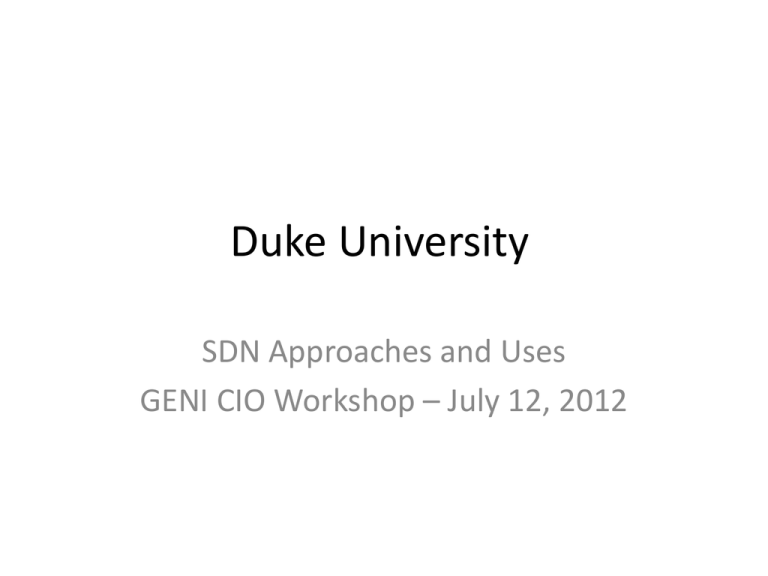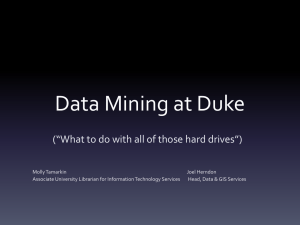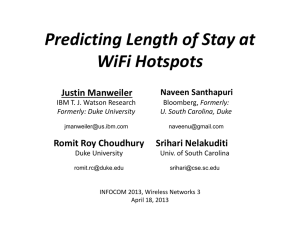Document
advertisement

Duke University SDN Approaches and Uses GENI CIO Workshop – July 12, 2012 Duke Network – Current State • Duke’s existing infrastructure has a great deal of flexibility – Campus core is 20Gbps today (40Gbps soon) – External connectivity is 20Gbps today – Extensive wireless (~3200 802.11n APs) + Wired – Utilizes MPLS/VRF (VPN Routing and Forwarding) technologies throughout the campus (multi bldg depts, etc) • More than 65 VPNs operating today, from PCI to e-PHI • Custom firewalls can be deployed for any VRF – IPS/IDS operating at network Interchange Layer • Inspects traffic in/out of Duke and VRF-to-VRF Duke Network – Current Operation MCNC (Commodity + I-2/NLR) Interchange Layer Campus “Backbone” Physics Department Institute for Genome Sciences & Policy Duke Shared Cluster Resource Duke Network – Current Operation MCNC (Commodity + I-2/NLR) Current Cross-domain Data Flow Interchange Layer Campus “Backbone” Physics Department Institute for Genome Sciences & Policy Duke Shared Cluster Resource Duke Network – Limitations • VRFs (VPNs) are configured by central IT – We’d like to give scientists more control and flexibility to create their own private VPNs with their collaborators on the campus network • IPS/IDS can add latency and complexity – We’d like known (safe) transmissions on campus to proceed without exhaustive security checks • External “big data” collaborations are the norm – We’d like to enable faster transmissions + more flexibility to access resources (cycles, storage) outside of Duke (without clogging the core network) Duke Network – SDN Approach • Leverage existing enterprise infrastructure and provide a bridge mechanism to enable SDN at the “edge” and take advantage of VRF capabilities where SDN is not yet deployed (in the “core”) – Retain the “rock solid” nature of the production network, WITHOUT creating a totally separate and independent physical research network • Extend Exo-GENI access via SDN capabilities • Enable “regular traffic” routes + “HOV/express” routes with planned points of ingress/egress – Enable scientists to opt-in to SDN connectivity as well as Exo-GENI capability Give scientists easy access to virtual slices (network, computation, storage) whether at Duke or beyond Duke Network – Current Operation MCNC (Commodity + I-2/NLR) RENCI’s Breakable Experimental Network (BEN) Interchange Layer SDN Enabled Only for ExoGENI Research Project in CS, with Direct Connection bypassing Duke Network Campus “Backbone” Duke CS – Exo-Geni Research Physics Department Institute for Genome Sciences & Policy Duke Shared Cluster Resource Duke Network – Future Operation MCNC (Commodity + I-2/NLR) RENCI’s Breakable Experimental Network (BEN) Interchange Layer SDN Capability Added to Edge Sites with Know Use Cases: Physics (DYNES and big data transfers externally), IGSP (research with ePHI implications) Campus “Backbone” Duke CS – Exo-Geni Research Physics Department Institute for Genome Sciences & Policy Duke Shared Cluster Resource Duke Network – Future Operation MCNC (Commodity + I-2/NLR) RENCI’s Breakable Experimental Network (BEN) Interchange Layer Future Cross-domain Data Flow: SDN-Mediated + Prepositioned-VRFs to Enable Shortest Path, bypass Interchange Campus “Backbone” Pre-positioned VRF Segment Duke CS – Exo-Geni Research Physics Department Institute for Genome Sciences & Policy Duke Shared Cluster Resource Prepositioned VRFs • Prepositioned VRFs can be used to connect an SDN edge endpoint with know collaboration sites in the core (non-SDN) network – Traffic routes around campus interchange layer • Avoids IPS/IDS checks – faster transmission of “big data” for researchers • Point-to-point routes mean less traffic in the “core” benefits other university users – Benefit to the SDN users: potentially higher bandwidth, lower latency paths Expressway Links • Med-/Long-term SDN connections between known (frequently accessed) end-points – Establishes direct traffic routes • Benefits are even greater than prepositioned VRF (even more direct), but less scalable since SDN required on both sides and fiber capacity needed between end-points – Enables ExoGENI experimentation and access to compute, storage and network “slices” beyond Duke to other SDN-enabled sites & ExoGENI racks Duke Network – Future Operation MCNC (Commodity + I-2/NLR) RENCI’s Breakable Experimental Network (BEN) I-2/ION Future External Data Flow: SDN-Mediated Interchange “Expressway” Layer Links: Enable Layer2 Transport and ExoGENI Resource Access Campus “Backbone” Duke CS – Exo-Geni Research Physics Department Institute for Genome Sciences & Policy Duke Shared Cluster Resource External Data Flow • SDN-enabled edge points can connect through a (pre-established) set of VPNs in the campus core (Layer 3) to reach external destinations • Where Expressway Links exist and connect to ExoGENI, SDN-enabled edge points can connect via BEN-ExoGENI (Layer 2) to reach external destinations






